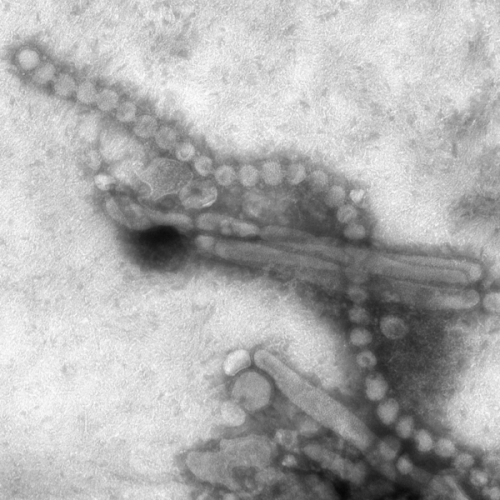Candidate H7N9 avian flu vaccine works better with adjuvant

An experimental vaccine to protect people against H7N9 avian influenza prompted immune responses in 59 percent of volunteers who received two injections at the lowest dosage tested, but only if the vaccine was mixed with adjuvant—a substance that boosts the body's response to vaccination. Without adjuvant, immune responses produced by the investigational vaccine were minimal regardless of vaccine dosage, according to findings from a clinical trial sponsored by the National Institute of Allergy and Infectious Diseases (NIAID), part of the National Institutes of Health.
The Phase 2 trial enrolled 700 healthy adults aged 19 to 64 years old at four NIAID-sponsored Vaccine and Treatment Evaluation Units (VTEU) in the United States. It was led by Mark J. Mulligan, M.D., of Emory University, Atlanta. Results appear in the current issue of the Journal of the American Medical Association.
The first recognized human H7N9 avian influenza cases occurred in China in early 2013. Most people who have become infected with the virus had contact with infected poultry. The virus does not sicken birds, but can cause people to become seriously ill, with approximately 67 percent of reported cases requiring hospitalization. As of September 4, 2014, a total of 452 laboratory confirmed cases, including 166 deaths, had been reported to the World Health Organization.
"Although this influenza virus does not currently spread easily from person to person, all novel influenza viruses have the potential to evolve to cause widespread illness or death," said NIAID Director Anthony S. Fauci, M.D. "Therefore, it is prudent to conduct clinical trials such as this one to be prepared in the event of an H7N9 avian influenza pandemic."
The experimental vaccine, made from inactivated H7N9 virus grown in chicken eggs, was manufactured by Sanofi Pasteur (Swiftwater, PA). The adjuvant, MF59, used widely in Europe but not licensed in the United States, was manufactured by Novartis Vaccines (Marburg, Germany) and was mixed with the vaccine just prior to use. Both products were supplied by the Biomedical Advanced Research and Development Authority (a part of the Department of Health and Human Services) from the National Pre-Pandemic Influenza Vaccine Stockpile.
The 700 study volunteers were divided into groups of approximately 100 each. All received two injections, spaced 21 days apart, and had blood drawn on both inoculation days as well as on three additional time points. Two groups received vaccine at either 15 micrograms (mcg) or 45 mcg without adjuvant. Without adjuvant, even those participants who received the higher dosage vaccine had minimal immune responses. This was not unexpected, as an earlier clinical trial of an experimental unadjuvanted vaccine based on H7 avian influenza virus elicited little or no detectable antibody responses.
The remaining five groups of participants received two injections of vaccine at one of three different dosages (3.75 mcg, 7.5 mcg or 15 mcg). Three of the groups received MF59 adjuvant with both inoculations, while the final two groups received only one dose of adjuvant with their first or second injection of vaccine. No serious vaccine-related adverse events were reported in any of the groups. Participants who received adjuvant reported more mild pain and tenderness at the inoculation site than those who received only vaccine. In general, the inoculations were well-tolerated and side effects were mild.
The researchers used a standard test called the hemagglutination inhibition (HAI) antibody assay to assess the likelihood that the experimental vaccine would provide protection against influenza disease. HAI levels of 40 or more signal that an influenza vaccine induced an immune reaction that is likely to prevent influenza disease. In this trial, the key HAI assays were performed on blood samples taken at 42 days after the first inoculation.
Among the volunteers who received two injections of the lowest dose of vaccine along with two doses of adjuvant, 59 percent had HAI levels of 40 or more. The most surprising finding, noted the researchers, came from the volunteer group that received 15 mcg dose vaccines and just one dose of MF59 at the time of the first vaccine. Among that group, the antibody responses were not significantly lower than those who received two doses of adjuvant, suggesting that a single dose of adjuvant given with the first dose of vaccine may be sufficient to prompt a significant immune response. If true, this would be of particular importance in the event of a pandemic, when adjuvant-sparing and vaccine antigen-sparing vaccine regimens could be used to stretch available supplies of vaccine and adjuvant as far as possible.
More information: MJ Mulligan et al. Serological responses to an avian influenza A/H7N9 vaccine mixed at the point-of-use with MF59 adjuvant: a randomized clinical trial. JAMA 2014; 312(14):1409-1419. DOI: 10.1001/jama.2014.12854
Editorial: doi:10.1001/jama.2014.12558

















